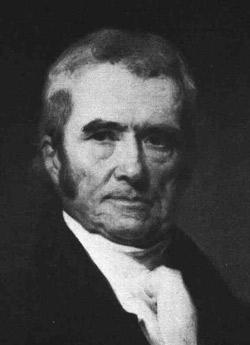Read all of Slate’s coverage about the Affordable Care Act.
More than 200 years ago, the Supreme Court handed down a decision that was destined to change the landscape of American politics and send generations of befuddled first-year law students scurrying to their legal dictionaries. Everyone knows Marbury v. Madison as the case in which the court first asserted the power to declare acts of Congress and the president unconstitutional. What’s less well known is that the defendants in Marbury (Secretary of State James Madison and, by extension, President Thomas Jefferson) got off on a technicality. In its first great clash with the president, the court concluded that it had no jurisdiction—no power, in other words, to award relief to the plaintiff. Marbury promised sizzle and ended with fizzle.
But all of this was by design. John Marshall, the brilliant but unassuming chief justice, always intended to use Marbury to hand his cousin and arch-foe Jefferson a narrow legal victory while dealing him a long-lasting political blow. By lecturing Jefferson about his legal duties, Marshall put the president in his place. (Ours is “a government of laws, and not of men.”) And by laying the foundation for judicial review, Marshall carved out a prominent new place for the court. Most important, Marshall did all of this without ordering Madison or Jefferson to actually do anything. No wonder historian Robert McCloskey called Marbury “a masterwork of indirection.”
Fast-forward to our own era’s great confrontation between the president and the Supreme Court, the constitutional challenge to Barack Obama’s health insurance reform act, which will be argued over the next three days. Much ink and many pixels have been spilled over whether the act’s requirement that individuals buy health insurance oversteps Congress’ power to regulate “commerce … among the several states.” But today’s opening argument in the case will be devoted to a more modest issue that, as in Marbury, could end up deciding the case: the question of the court’s jurisdiction.

Chip Somodevilla/Getty Images.
Stay with me here; this gets a bit technical. The health reform act says that, starting in 2014, people who don’t buy insurance will have to pay a penalty to be collected by the IRS through the income tax system. Another federal law, called the Anti-Injunction Act, says that lawsuits to stop “the assessment or collection of any tax” cannot be “maintained in any court.” The point of the Anti-Injunction Act is to make sure that people pay their taxes up front and save any court challenges for later, in the form of a request for a refund.
When the Obama administration started getting hit with lawsuits attacking the health insurance mandate, it argued that those suits were premature under the Anti-Injunction Act because a challenge to the mandate is a challenge to the penalty, which is in essence a tax, and nobody has had to pay the tax yet. The administration has since dropped that line of defense. But the Supreme Court ordered a Washington lawyer, Robert Long, to renew the argument, which he will do for 40 minutes today. In his briefs, Long has built a strong case that the Anti-Injunction Act strips the court of jurisdiction over the health care lawsuits for the time being. (Disclosure: I worked with Long on a couple of cases a decade ago.)
Don’t get me wrong: The Anti-Injunction Act defense isn’t watertight. But neither was the argument against the court’s jurisdiction in Marbury. And deflecting the case in this way would carry several advantages for John Roberts and the institution over which he presides. Roberts assumed the chief justice’s chair pledging to craft narrow, unanimous opinions rather than broad, fragmented ones whenever possible. This is a perfect opportunity to do just that. The court’s conservatives, who tend to take a narrow view of the court’s jurisdiction, might sign on to an opinion that dodges the merits, and the court’s more liberal members might go along if the alternative were a divided opinion striking down the mandate. The justices may welcome the opportunity to sidestep another Bush v. Gore scenario or Citizens United-style blowback by staying out of the fracas over a sitting president’s signature legislative achievement during an election year.
In a crass partisan sense, a decision to avoid the constitutional issues would keep the health care law—and the “Obamacare” issue—alive for Republicans to run against in the fall, an outcome the president’s political advisers might not wholeheartedly welcome. Beyond that, in order to decide the case on Anti-Injunction Act grounds, the court would have to hold that the mandate operates as a tax—still more political grist for the Republican mill. These are not legal considerations, of course, but as Marbury shows, the greatest justices are always aware of the political implications of their rulings.
Conventional wisdom says the Anti-Injunction Act won’t be the surprise protagonist in this Supreme Court saga. For one thing, a decision that effectively labeled the mandate a tax, though it would harm Obama politically in the short term, would actually shore up his health reform law against an eventual constitutional challenge, since the federal power to “lay and collect taxes” is virtually unlimited. For another, health insurers and other business interests would rather not wait until after 2014 to know the legal lay of the land. And as Dahlia Lithwick points out, the conservative justices could earn themselves some wiggle room for other cases by voting to uphold the health reform act now. Finally, there’s the question of why the court would schedule six hours of oral argument only to dismiss the case in the mother of all anticlimaxes.
But there is precedent for just such a passive-aggressive outcome. The justices ducked the question of the Pledge of Allegiance’s constitutional validity on a rather shaky jurisdictional basis in 2004, an election year that featured the pledge as a live political issue. (Those were the days!) A more recent example suggests the current chief justice might favor such an approach: in 2009, he surprised many observers by authoring a near-unanimous decision dodging the issue of the Voting Rights Act’s constitutionality on dubious technical grounds.
Personally, I’d like the court to decide these cases on the merits, because I think the arguments in favor of the law’s constitutionality are overwhelming. Still, there’s a decent chance that our latest brilliant but unassuming chief justice will borrow a trick from his greatest predecessor and persuade his colleagues to decide not to decide.
